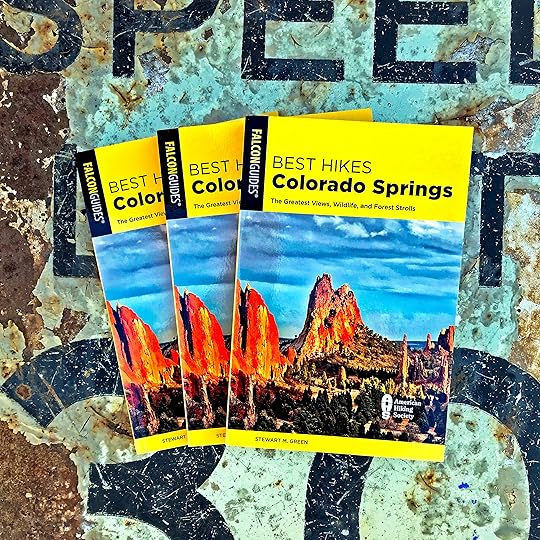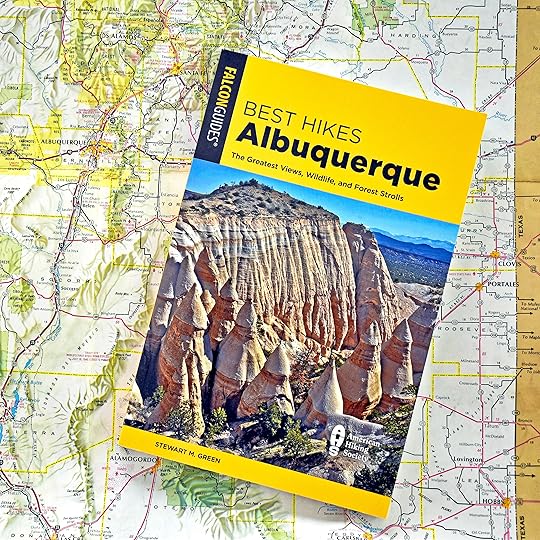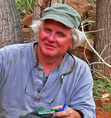Stewart M. Green's Blog, page 2
February 15, 2022
New Garden of the Gods Sign Explains the Mysteries of Climbing
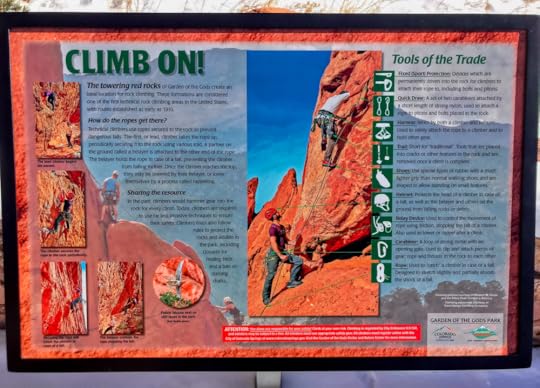
Rock climbing is a mystery, a complete and total mystery to most of the American public. The average tourist can watch climbers, see the foot and hand techniques, the rope work, the gear, and still not have an elementary grasp of climbing.
To flatlanders, those land-locked folks from Kansas, Texas, Missouri, Florida, and Illinois that I encounter at the Garden of the Gods, climbing is a mystery. A group can be standing on the paved footpath that encircles the central Garden zone, watching climbers edging up the vertical sandstone faces, clipping the rope into fixed pitons, anchoring into bolts on tiny ledges, and still not understand how climbing is done, let alone know the answer to that enigmatic question: Why?
To answer the questions posed by millions of visitors to the Garden of the Gods, the Colorado Springs parks department has finally installed a sign that explains how the rope gets up there, how climbers help preserve the rock resource, and the "Tools of the Trade," which explains the arcane equipment that climbers use for safe ascents.
The sign has been in process for several years, which began when park ranger Wes Herman proposed it and then got together with Brian Shelton and me to talk about what should be on the sign. He wrote the copy and Brian and I edited it for accuracy.
Then I shot the photos for the sign, going out for an afternoon with Isaac Hamilton and CJ Sidebottom, who posed as expert models. Isaac was a particularly good sport, taking a dozen leader falls for me to click the right photograph.
I went out to the Garden of the Gods for a snowy birthday walk in early February and found that the sign has finally been installed at an overlook below the west face of North Gateway Rock.
So, if you have any questions about climbing and how the heck we get the ropes up (no, it's not with trained pigeons), then the new sign will help you understand the mysteries of climbing...
Below: Stewart Green and the new climbing sign at the Garden of the Gods below the west face of North Gateway Rock, Colorado.
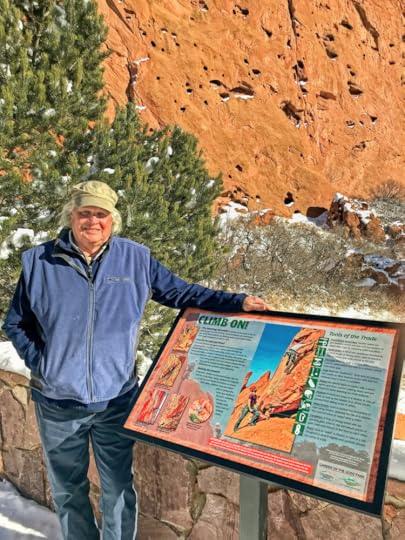
January 7, 2022
NEW! Hiking Colorado's Hidden Gems out April 1

I locked the final cover of my newest book HIKING COLORADO'S HIDDEN GEMS with FalconGuides a month ago. The 256-page book, generously illustrated with spectacular photographs, will be officially released on April 1, 2022, a month later than its initial release date due to supply chain issues.
It was a long, strange trip getting the book finished after massive wildfires in Colorado in 2020 and the pandemic lockdown. I had to cut three hikes from the book because of fire damage and make last-minute substitutions of others so I turned the book in late, much to the chagrin of my editor and the publisher. But the beast got edited, laid out, proofed, and now is getting printed.
HIKING COLORADO'S HIDDEN GEMS is a milestone since it will be the 70th separate book, including all of the editions of all of the other books, that I will have published. I'm excited about that!! You can see all of my life's work on my Amazon Author's Page.
This book details 40 hikes around Colorado that I enjoy. Some I've hiked many times, others only a couple of times. These include treks at Canyon of the Ancients National Monument, Mesa Verde National Park, Rocky Mountain National Park, the South Slope of Pikes Peak, Florrisant Fossil Beds National Monument, Picketwire Canyonlands, and other cool places. The book does not, however, have any remote and unknown places in Colorado, but instead offers established trails that are not well known by many folks.
Place an advance order for your copy of HIKING COLORADO'S HIDDEN GEMS and make plans for some wonderful summer adventures. See you on the trail!
Here are some of my other books that might provide more great hikes, climbs, drives, and adventures:
SCENIC DRIVING COLORADO SCENIC DRIVING NEW ENGLAND ROCK CLIMBING COLORADO BEST HIKES ALBUQUERQUE CLIMBING PIKES PEAK: A HIKER'S GUIDE TO THE PEAKDecember 26, 2021
The Cliff Cities of the Ancient Ancestors
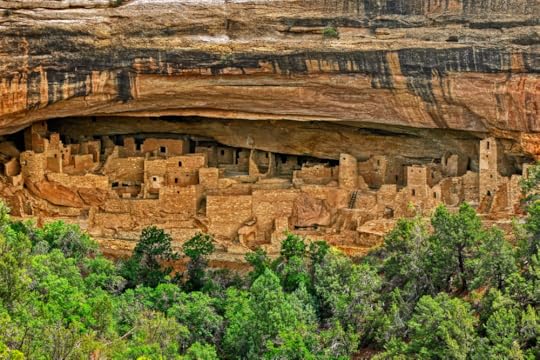
I first visited Mesa Verde National Park, the archeological wonder of the United States, when I was a wee lad in the late 1950s. In the 1960s, my family made annual summer pilgrimages to Mesa Verde to marvel at the stone cities of the Ancient Ones, aeries tucked in vaulting sandstones caves that were preserved for almost a thousand years like a fly in amber.
Those trips to the magical and mysterious ruins of the Ancestral Puebloan people at Mesa Verde, Hovenweep, Chaco Canyon, Frijoles Canyon, Canyon de Chelly, Wupatki, and Tsegi Canyon began my obsession with archeology (I later received a degree in anthropology/archeology) and the past lives seen through the prism of material artifacts.
To see a perfectly preserved black-on-white olla and realize that a long-dead craftsman carefully dug the clay from a creek bed, molded and shaped it into a beautiful utilitarian vessel, fired it in a smoldering campfire, and then used it for hauling water or storing precious seed corn. To see that object is to look into the past and know something about vanished people that lived, loved, worked, and finally died, their desiccated remains buried in a midden before their cliffside home.
Mesa Verde’s moldering cities also gave me a zest for the pleasure of ruins, an attraction to ruination and the decay of civilization and culture, to the past glories of the vanished and vanquished. Cities decline and are emptied of people, their houses, buildings, and streets begin to return to the earth, dust to dust, ashes to ashes. Some slowly melt into the shadowy jungle, covered in vines and trees. Others dissolve beneath rivers and seas, inundated by water like Grecian ruins beneath the Aegean Sea or the mythical cities of Atlantis. In the deserts, these once so-human places become the crumbling haunt of lizards, snakes, and owls. Cisterns fill with sand, and domes and towers become eyeless phantoms.
The pleasure of ruins is to look backward at the stupendous past, at the places of legend and myth, at the altar of unknown prehistory before the written word described and remembered those who came before. I don’t think of it as melancholia or a romantic vision of life before we inhabited the earth, instead, it’s an intoxication with the present, with us, those who live now. Instead of mere stones laid in a wall or a vacant doorway, the ruin is about dreams and myths, about who we are now as frail humans on this warming planet, about our evolution as well as our disgraces, about the lessons we can learn about decay and pride and ignorance.
The ghosts of those who went before us at Mesa Verde, Babylon, Thebes, Troy, Rome, Pompeii, Machu Picchu, Stonehenge, and Delphi are part of an alien world with people that spoke alien tongues and saw the cosmos as a paradox, as an angry, benevolent, and mysterious place. They pecked glyphs on sandstone walls and carved bas-reliefs of gods and goddesses, eagle-headed men, winged bulls, hump-backed flute players, hunters, priests, pharaohs, and queens. They made great cities that are now shattered ruins, just as our great cities will one day be void of humans and filled with feral cats, songbirds, and those other lives that will inherit the earth.
So, the long-abandoned and deserted cliff cities at Mesa Verde and the multi-storied pueblos at Chaco Canyon in a dusty valley have fallen into ruinous decay over a millennium. Walls overgrown with sagebrush clumps. Sites plundered and quarried by selfish hands. Once, like the world’s other fallen cities, these were hives of activity, filled with artists and artisans, lorded over by time-traveling shamans, buzzing with gossip and news from afar. Here was a plaza where traders spread their feathered talismans and turquoise necklaces, there a rooftop where children played and laughed.
Take me back to those years and show me something real in the desolation, something that reaches across the centuries and touches me, like the smoothness of that perfect olla made by a master potter. That’s something real, something tangible, an object that remembers the daily pleasure of life. Touching that olla takes me back. I can smell the burning fires, hear the bark of a dog, and across the canyon, I hear the steady thump of a drum and voices singing. Here in this place, I feel the presence of the old ones. They’ve been gone a long time, but they’re happy I came and sat quietly in the morning sunshine.
I shot this photograph of Cliff Palace, the largest and grandest cliff dwelling, from the rimrock of Cliff Canyon last summer. This sacred space contained over 150 rooms and 23 kivas or ceremonial chambers. Over 100 people lived in the city. Life was short and brutal for its inhabitants, with an average lifespan of 34 years and a high rate of infant mortality with almost half of all children dying before age 5.
To learn more about the ancient ones, their cliffed cities, and the galleries of creative rock art they left behind on cliff faces and shelter caves, pick up a copy of my book ROCK ART: THE MEANINGS AND MYTHS BEHIND ANCIENT RUINS IN THE SOUTHWEST AND BEYOND from FalconGuides.
July 3, 2021
NEW EDITION of 1878 BOOK! "Colorado: Bits of Travel at Home" by Helen Hunt Jackson
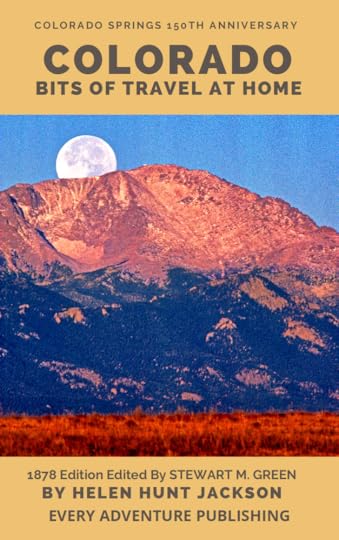 I’m happy to announce the release of my newest book: ,Colorado: Bits of Travel at Home by Helen Hunt Jackson on Kindle. Originally published in 1878, I reimagined the Colorado section of this book of fascinating travel essays by the Grande Dame of Colorado writers by editing it for the modern reader, updating spellings and writing conventions; and profusely illustrating it with my color photographs. In late 1873 best-selling author and poet Helen Hunt moved to Colorado from her native New England for the Mountain West’s dry, bracing air. Settling in Colorado Springs, which had only been established two years before, Helen Hunt explored frontier Colorado and Colorado Springs and wrote about her adventures for magazines, including The Atlantic and New York Independent. These Colorado travelogues were published, along with others about New England and California, in her book ,Bits of Travel at Home. This reprint by Every Adventure Publishing of the book’s Colorado section, entitled ,Colorado: Bits of Travel at Home, is published for this month’s 150th anniversary of the founding of Colorado Springs in 1871. The book's fascinating chapters detail the beginnings of Colorado and give firsthand observations of those halcyon frontier days and the first settlers, hard-rock miners, and upstanding citizens.As a literary journalist, Helen Hunt Jackson, traveling by carriage, horse, and railroad, roamed around Colorado’s Front Range for four years, interviewing miners living above 14,000 feet near Fairplay, descending into mines at Central City, traveling to the end of the railroad tracks in the San Luis Valley, and rejoicing in the natural beauty of Colorado Springs, her new hometown, and its spectacular natural wonders like Pikes Peak and the Garden of the Gods.Looking back over 150 years, ,Colorado: Bits of Travel at Home offers a glimpse of the original Colorado and its colorful history. The book, indispensable reading for any lover of Colorado, includes an introduction to Helen Hunt Jackson from 1899 as well as new commentary that I wrote to preface each chapter, including ones about Fairplay, Boulder Canyon, Georgetown, the San Luis Valley, and Colorado Springs. I also included a new chapter about the vanished Seven Lakes that has not been printed since 1879. The book is ,available on Kindle for the bargain price of $2.99, the lowest price that Amazon will let me charge. You can download it on the Kindle app on your phone, tablet, or other digital devices. If you buy ,Colorado: Bits of Travel at Home, read it, and love it, please write a review on Amazon and let other folks know your good thoughts!
I’m happy to announce the release of my newest book: ,Colorado: Bits of Travel at Home by Helen Hunt Jackson on Kindle. Originally published in 1878, I reimagined the Colorado section of this book of fascinating travel essays by the Grande Dame of Colorado writers by editing it for the modern reader, updating spellings and writing conventions; and profusely illustrating it with my color photographs. In late 1873 best-selling author and poet Helen Hunt moved to Colorado from her native New England for the Mountain West’s dry, bracing air. Settling in Colorado Springs, which had only been established two years before, Helen Hunt explored frontier Colorado and Colorado Springs and wrote about her adventures for magazines, including The Atlantic and New York Independent. These Colorado travelogues were published, along with others about New England and California, in her book ,Bits of Travel at Home. This reprint by Every Adventure Publishing of the book’s Colorado section, entitled ,Colorado: Bits of Travel at Home, is published for this month’s 150th anniversary of the founding of Colorado Springs in 1871. The book's fascinating chapters detail the beginnings of Colorado and give firsthand observations of those halcyon frontier days and the first settlers, hard-rock miners, and upstanding citizens.As a literary journalist, Helen Hunt Jackson, traveling by carriage, horse, and railroad, roamed around Colorado’s Front Range for four years, interviewing miners living above 14,000 feet near Fairplay, descending into mines at Central City, traveling to the end of the railroad tracks in the San Luis Valley, and rejoicing in the natural beauty of Colorado Springs, her new hometown, and its spectacular natural wonders like Pikes Peak and the Garden of the Gods.Looking back over 150 years, ,Colorado: Bits of Travel at Home offers a glimpse of the original Colorado and its colorful history. The book, indispensable reading for any lover of Colorado, includes an introduction to Helen Hunt Jackson from 1899 as well as new commentary that I wrote to preface each chapter, including ones about Fairplay, Boulder Canyon, Georgetown, the San Luis Valley, and Colorado Springs. I also included a new chapter about the vanished Seven Lakes that has not been printed since 1879. The book is ,available on Kindle for the bargain price of $2.99, the lowest price that Amazon will let me charge. You can download it on the Kindle app on your phone, tablet, or other digital devices. If you buy ,Colorado: Bits of Travel at Home, read it, and love it, please write a review on Amazon and let other folks know your good thoughts!
May 1, 2021
The Black Canyon: Colorado's Deepest Gorge
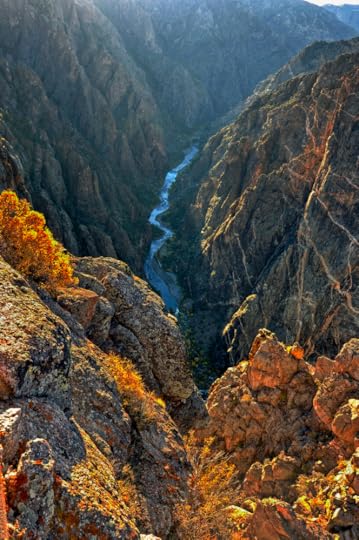 Looking down the lower Black Canyon of the Gunnison from the South Rim. Photograph © Stewart M. GreenDriving south from Hotchkiss toward the Black Canyon of the Gunnison, that’s how it is. Nothing prepares the traveler for the inaccessibility and oldness of the canyon. Along the North Rim of the Black Canyon: sudden airy space falls away to nothingness, the buoyancy of empty air. Below lies precipices of rock, rock, and more rock. Dark menacing granitic walls that soar, unbroken except by vertical cracks, occasional rubble gullies, and sloping ledges stalked with tall pine trees.The strength of the Gunnison River far below the rim is ever-present. This canyon is its masterpiece. Most of the narrow canyon was excavated during the past 30 million years after regional uplifts gave the snowmelt-laden river a steep cutting gradient and the coarse runoff from past Ice Ages filled the river with sand and boulders as primitive cutting tools, rock on rock.The sound of the Black Canyon is silence. The quiet of the depths. Below is only space and the river’s roar, its musical tones muted, absorbed, and deadened by rock walls. As brilliant sunlight fills the rim, deep shadows blacken the gullies and under summer’s noonday sun, the south-facing canyon cliffs bake like hot ovens. Sunlight drapes the sharp edges of long arêtes and whitens the dragon-striped pegmatite bands that crisscross the walls.
Looking down the lower Black Canyon of the Gunnison from the South Rim. Photograph © Stewart M. GreenDriving south from Hotchkiss toward the Black Canyon of the Gunnison, that’s how it is. Nothing prepares the traveler for the inaccessibility and oldness of the canyon. Along the North Rim of the Black Canyon: sudden airy space falls away to nothingness, the buoyancy of empty air. Below lies precipices of rock, rock, and more rock. Dark menacing granitic walls that soar, unbroken except by vertical cracks, occasional rubble gullies, and sloping ledges stalked with tall pine trees.The strength of the Gunnison River far below the rim is ever-present. This canyon is its masterpiece. Most of the narrow canyon was excavated during the past 30 million years after regional uplifts gave the snowmelt-laden river a steep cutting gradient and the coarse runoff from past Ice Ages filled the river with sand and boulders as primitive cutting tools, rock on rock.The sound of the Black Canyon is silence. The quiet of the depths. Below is only space and the river’s roar, its musical tones muted, absorbed, and deadened by rock walls. As brilliant sunlight fills the rim, deep shadows blacken the gullies and under summer’s noonday sun, the south-facing canyon cliffs bake like hot ovens. Sunlight drapes the sharp edges of long arêtes and whitens the dragon-striped pegmatite bands that crisscross the walls.
March 9, 2021
Pasqueflowers: Harbinger of Colorado Spring
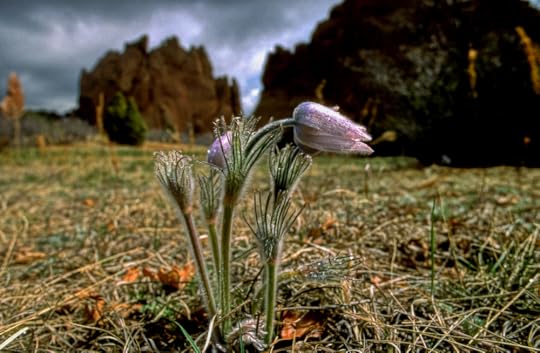
February 11, 2021
Remembering Mark Hesse: Climber and Trailbuilder
 I first met Mark in 1970 when Billy Westbay and I started climbing with him. That year, Billy and I began going up to Boulder almost every free weekend to climb at Eldo, solo the Flatirons, or crank testpieces in Boulder Canyon, like Athlete's Feat which we first did with Mark.Usually, we bivouacked at Mark's house on The Hill in Boulder. It was across the street from a cemetery so occasionally Billy and I unrolled our sleeping bags in the grass but we always avoided the graves. We slept like the dead. Or rather, with the dead. When he wasn't studying, Mark would go climbing with us lads. Those were good days. After thinking about Mark on the day of his passage to the higher peaks, I dug out a roll of black-and-white photographs that I shot of Mark in July 1984 for a magazine article. Mark and I scrambled around on the upper East Face of Gray Rock at the Garden of the Gods to get the photographs. They capture his essence, confidence, smile, and friendly demeanor.I hope you're enjoying those cliffs and peaks on the other side and organizing some trail-building. I'm sure heaven's paths could use some maintenance and love. We miss you, Mark.Images: Mark Hesse at the Garden of the Gods, Colorado, in July 1984. Photographs © Stewart M. Green
I first met Mark in 1970 when Billy Westbay and I started climbing with him. That year, Billy and I began going up to Boulder almost every free weekend to climb at Eldo, solo the Flatirons, or crank testpieces in Boulder Canyon, like Athlete's Feat which we first did with Mark.Usually, we bivouacked at Mark's house on The Hill in Boulder. It was across the street from a cemetery so occasionally Billy and I unrolled our sleeping bags in the grass but we always avoided the graves. We slept like the dead. Or rather, with the dead. When he wasn't studying, Mark would go climbing with us lads. Those were good days. After thinking about Mark on the day of his passage to the higher peaks, I dug out a roll of black-and-white photographs that I shot of Mark in July 1984 for a magazine article. Mark and I scrambled around on the upper East Face of Gray Rock at the Garden of the Gods to get the photographs. They capture his essence, confidence, smile, and friendly demeanor.I hope you're enjoying those cliffs and peaks on the other side and organizing some trail-building. I'm sure heaven's paths could use some maintenance and love. We miss you, Mark.Images: Mark Hesse at the Garden of the Gods, Colorado, in July 1984. Photographs © Stewart M. Green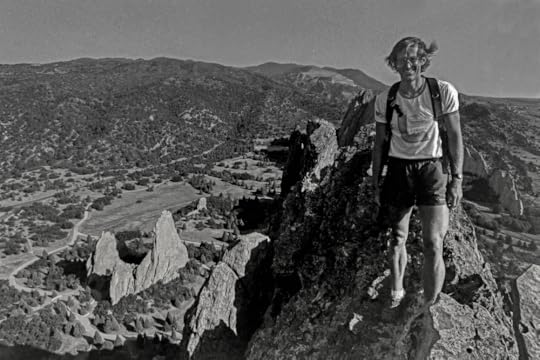
January 10, 2021
Rock Climbing at Acadia National Park
I had a blast climbing all over superb crags and areas like Cathedral and Whitehorse Ledges, Cannon Cliff, Rumney, Crow Hill, Quincy Quarries, Wheeler Mountain, and the cliffs at Acadia National Park on the Maine coast.
Acadia, a crown jewel in the National Park system, is a crossroads where wooded mountains meet the restless Atlantic Ocean at a dramatic interface between cliff and surf. Cadillac Mountain, the highest point on the eastern seaboard at 1,530 feet, is the place where the rising sun first gilds the United States. Its rugged topography was sculpted and polished by great glaciers, some as thick as 9,000 feet, with the last one retreating a mere 15,000 years ago.
Climbers come to Acadia National Park and the Maine coast not just for "lobstah" and slaw but also for climbing on one of the few sea cliffs on the Atlantic coast. Otter Cliff, composed of compact granite, stretches for 500 feet on the coastline near Otter Point. The 50- to 60-foot-high cliff, cleaved by cracks, corners, and aretes, offers stellar climbing above lapping waves and mostly moderate routes with crimps, layaways, and occasional hand jams.
I spent a week that August at Acadia with Martha Morris, tenting at Blackwoods Campground, hiking trails through damp woods, and climbing on sunny cliffs at the Bubbles, The Precipice's South Wall, and, of course, Otter Cliff.
Of course, I never let fun times get in the way of serious book research like making topos, creating route descriptions, measuring pitch and trail lengths, or shooting action photographs. The serious work of an author never ends...
I shot this photograph of Martha, belayed by Eric Morin, pulling down on Razor Crack on the far left side of Otter Cliff. Unfortunately, the airy route, one of the cliff's best climbs, toppled into the storm surge on a dark night in 2008 along with Black Crack and Riptide.
A photo from this shoot was on the cover of that first edition of Rock Climbing New England as well as on page 230 in the current second edition, so the route, in a sense, still has life on bookshelves and gear closets.
Buy My Book ROCK CLIMBING NEW ENGLAND
Photo below: Eric Morin belays Martha Morris on Razor Crack on a bluebird day at Acadia National Park. Photograph © Stewart M. Green
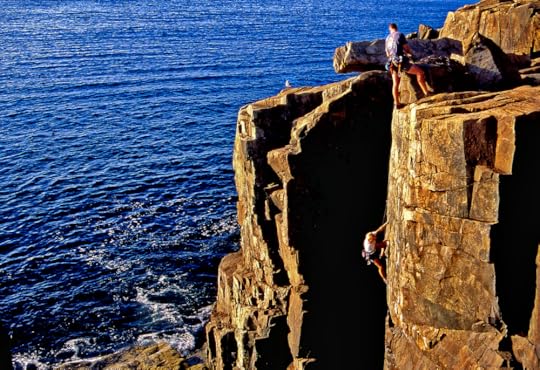
December 20, 2020
Penitente Canyon: Magic and Mystery in Southern Colorado
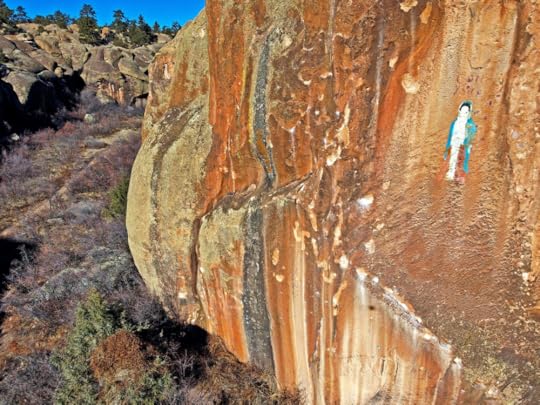 The painting of the Virgin of Guadalupe was painted by the Penitent Brothers on a cliff in Penitente Canyon in southern Colorado's San Luis Valley. Photograph ,© Stewart M. GreenPenitente Canyon, on the western edge of the San Luis Valley, a Connecticut-sized basin in southern Colorado, has long been a sacred place. While climbers come in droves now to ascend the gritty walls of volcanic tuff, the solidified remains of one of the largest volcanic eruptions in the earth’s history, other peoples have visited and lived in the canyon for literally thousands of years.
The painting of the Virgin of Guadalupe was painted by the Penitent Brothers on a cliff in Penitente Canyon in southern Colorado's San Luis Valley. Photograph ,© Stewart M. GreenPenitente Canyon, on the western edge of the San Luis Valley, a Connecticut-sized basin in southern Colorado, has long been a sacred place. While climbers come in droves now to ascend the gritty walls of volcanic tuff, the solidified remains of one of the largest volcanic eruptions in the earth’s history, other peoples have visited and lived in the canyon for literally thousands of years. Paleo-people hunted game, gathered edible plants, and lived among the rocks as long ago as 10,000 years. More recent native people include the Ancestral Puebloans, descendants of the ancient ones who once lived in the Four Corners region, the Utes, and the Jicarilla Apache. Remains of their passage are occasional projectile points found on the stony canyon rims and a legacy of rock art, mostly pictographs painted on secluded overhanging rock walls.
High on a south-facing wall in Penitente Canyon is perhaps the most visible reminder of those who came before, a painting of the Virgen de Guadalupe, also called Nuestra Señora de Guadalupe.
The Virgin, revered by Mexican Catholics, appeared four times in December 1531 to poor Juan Diego and once to his uncle Juan Bernadino on Tepeyac, a hill near Mexico City. The beautiful apparition spoke to him in his native Nahuatl, telling him to build a chapel there to honor her. Juan Diego reported the visitation to the archbishop, who, of course, didn’t believe him and asked for proof. On her fifth visit, the Virgen told Juan Diego to gather roses on the mountaintop and she placed them in his cloak. When he returned to the archbishop, he opened his cloak and the flowers fell to the floor, and an image of Nuestra Señora appeared on the cloak’s fabric. Que milagro!
The painting of the Virgen de Guadalupe was probably painted in the 1920s or 1930s by members of Los Hermanos Penitentes, the Penitent Brothers, a Catholic sect that integrated Catholicism and Franciscan mysticism with native beliefs and rituals. The Penitentes incorporated physical suffering, including flagellation, ritual death, and crucifixion, as part of the symbolism of moving from darkness into the light.
The brothers gathered by the early 1800s in moradas, a type of chapel without ecclesiastical oversight, and also evolved into political organizations. Without sacraments and priests, the Penitentes developed their own rituals and pathways to enlightenment.
One of these rituals was a reenactment of the Passion Play, the death of the Christ by crucifixion. Some Hermanos actually nailed a member to a cross and several died from their crucifixion wounds, a personal stigmata. The Brotherhood, retreating underground away from negative publicity, still exists as an egalitarian religious community in the San Luis Valley and northern New Mexico.
One of the Penitentes, using a basic palette of red, blue, white, and black, painted the Virgin about 40 feet above the cliff base in the central section of the canyon, probably suspended by a rope. Above the likeness, the words “Con Sufrimiento y Consuelo,” translated “With Suffering and Consolation,” were inscribed in red paint. The names of three of the brothers, Victor, Abel, and Victor, were painted at the cliff base but are now almost faded away.
In the early 1980s, the painting was touched up, supposedly by an artist sitting in a tire suspended from the clifftop with his paint pots around him. The three names at the base were possibly made at that time. Not long afterward a drunkard stopped by to use the sacred Virgin for target practice, destroying the face and pocking the surrounding rock. A couple climbers later rappelled down and filled the offending holes.
Here are a couple of photographs that I shot of the Virgin painting. One is an image I took a couple of weeks ago and the other is of Ian Green climbing to the right of the Virgin in 1996. The painting has faded and flakes of paint have fallen off since I first saw the unique painting in 1989 on my first visit to Penitente Canyon.
It is still a compelling icon. Walking up the canyon now on a deserted morning, it’s easy to imagine a band of hooded Brothers gathered among the scrub oak below the painting during Easter week, their voices raised in hymn and prayer and echoing down the soulful canyon.
Want to go rock climbing at Penitente Canyon? Check out my book ROCK CLIMBING COLORADO for directions, route descriptions, photo topos, and action photographs.
December 11, 2020
Give the Gift of Books This Year: Check Out My New Adventure Books
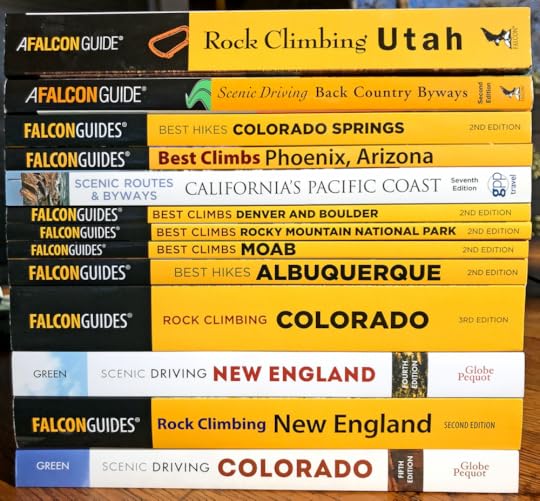 Once again, it’s the annual holiday season, the giving time of the year. Most of us are trying to figure out what kind of gifts to give and surprise our friends, colleagues, and loved ones to cement our relationships in this reciprocal ritual.
Once again, it’s the annual holiday season, the giving time of the year. Most of us are trying to figure out what kind of gifts to give and surprise our friends, colleagues, and loved ones to cement our relationships in this reciprocal ritual. I’ve always given the gift of books because reading is simply one of the best activities that your mind can do. Books teach us lessons, take us on magical journeys, lead us to wonderful and beautiful places, and enrich our lives.
I always look at most of the books that I write and publish as Books of Dreams.
Pick up a book like Rock Climbing Utah , Scenic Driving New England , or Best Hikes Colorado Springs and get transported to new places through brilliant photographs, historical tidbits, and step-by-step directions to find and fulfill your secret dreams.
I’ve written, revised, edited, and photographed a lot of books, so many that it seems I can hardly keep track of them anymore. It’s really kind of funny because when someone asks me, “How many books have you written?” I don’t know the exact answer. Funny because most folks would like to have just one volume with a lush color cover and all of their words inside and their name in 72-point spotlights on the cover. It’s not that I’m jaded, but once I put a book to bed, it’s out of my mind because I’m already knee-deep in the next project.
If you’re wondering this December what to give that special someone, why not a book? Most of us writers are hurting this year since book sales plummeted with the pandemic. I know my royalties are over 50% down versus the previous couple of years.
If you’re looking to give friends and family a Book of Dreams this pandemic holiday season, head over to your friendly outdoor shops like Mountain Chalet or REI in Colorado Springs, a local bookstore, or hit the Amazon website and find a novel, picture book, non-fiction thriller, or book of outdoor dreams. Don’t forget that you can also order e-books for Kindle, iPad, Nook, and even mobile phones.
I would suggest, of course, that you give one of my books!
I have plenty of new editions of books that came out this year, including Climbing Pikes Peak , Best Climbs Moab , Best Climbs Denver and Boulder , Best Climbs Rocky Mountain National Park , Best Hikes Albuquerque , and Best Hikes Colorado Springs .
Others are the long-time bestseller Rock Climbing Colorado , Rock Climbing New England , Rock Climbing Utah , Scenic Driving Colorado , Scenic Driving New England , and the new favorite, Rock Art: The Meanings and Myths Behind Ancient Ruins in the Southwest and Beyond .
Check out the links on my Amazon Author’s pages below for details about all of my books and buy the gift of reading. Your adventurous loved ones will appreciate your thoughtfulness. And keep on dreaming!
BUY STEWART M. GREEN BOOKS FOR HOLIDAY GIFTS!
Climbing Pikes Peak
Best Hikes Colorado Springs
Best Hikes Albuquerque
Rock Climbing Colorado
Scenic Driving Colorado
Rock Climbing Utah
Best Climbs Moab
Best Climbs Denver and Boulder
Scenic Driving New England
